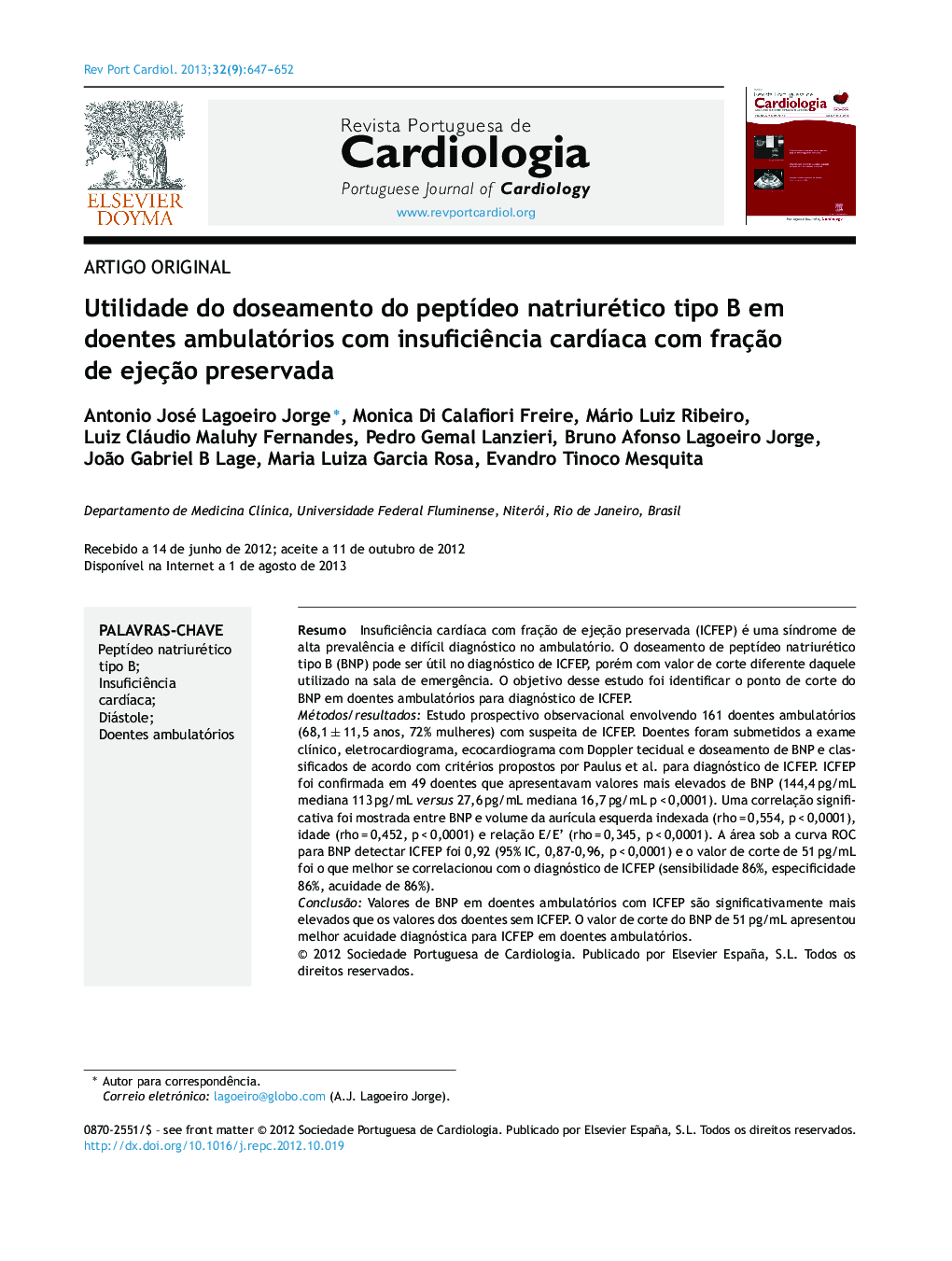| Article ID | Journal | Published Year | Pages | File Type |
|---|---|---|---|---|
| 1125734 | Revista Portuguesa de Cardiologia | 2013 | 6 Pages |
ResumoInsuficiência cardíaca com fração de ejeção preservada (ICFEP) é uma síndrome de alta prevalência e difícil diagnóstico no ambulatório. O doseamento de peptídeo natriurético tipo B (BNP) pode ser útil no diagnóstico de ICFEP, porém com valor de corte diferente daquele utilizado na sala de emergência. O objetivo desse estudo foi identificar o ponto de corte do BNP em doentes ambulatórios para diagnóstico de ICFEP.Métodos/resultadosEstudo prospectivo observacional envolvendo 161 doentes ambulatórios (68,1 ± 11,5 anos, 72% mulheres) com suspeita de ICFEP. Doentes foram submetidos a exame clínico, eletrocardiograma, ecocardiograma com Doppler tecidual e doseamento de BNP e classificados de acordo com critérios propostos por Paulus et al. para diagnóstico de ICFEP. ICFEP foi confirmada em 49 doentes que apresentavam valores mais elevados de BNP (144,4 pg/mL mediana 113 pg/mL versus 27,6 pg/mL mediana 16,7 pg/mL p < 0,0001). Uma correlação significativa foi mostrada entre BNP e volume da aurícula esquerda indexada (rho = 0,554, p < 0,0001), idade (rho = 0,452, p < 0,0001) e relação E/E’ (rho = 0,345, p < 0,0001). A área sob a curva ROC para BNP detectar ICFEP foi 0,92 (95% IC, 0,87-0,96, p < 0,0001) e o valor de corte de 51 pg/mL foi o que melhor se correlacionou com o diagnóstico de ICFEP (sensibilidade 86%, especificidade 86%, acuidade de 86%).ConclusãoValores de BNP em doentes ambulatórios com ICFEP são significativamente mais elevados que os valores dos doentes sem ICFEP. O valor de corte do BNP de 51 pg/mL apresentou melhor acuidade diagnóstica para ICFEP em doentes ambulatórios.
IntroductionHeart failure with preserved ejection fraction (HFPEF) is a highly prevalent syndrome that is difficult to diagnose in outpatients. The measurement of B-type natriuretic peptide (BNP) may be useful in the diagnosis of HFPEF, but with a different cutoff from that used in the emergency room. The aim of this study was to identify the BNP cutoff for a diagnosis of HFPEF in outpatients.Methods and ResultsThis prospective, observational study enrolled 161 outpatients (aged 68.1 ± 11.5 years, 72% female) with suspected HFPEF. Patients underwent ECG, tissue Doppler imaging, and plasma BNP measurement, and were classified in accordance with algorithms for the diagnosis of HFPEF. HFPEF was confirmed in 49 patients, who presented higher BNP values (mean 144.4 pg/ml, median 113 pg/ml, vs. mean 27.6 pg/ml, median 16.7 pg/ml, p < 0.0001). The results showed a significant correlation between BNP levels and left atrial volume index (r=0.554, p < 0.0001), age (r = 0.452; p < 0.0001) and E/E′ ratio (r = 0.345, p < 0.0001). The area under the ROC curve for BNP to detect HFPEF was 0.92 (95% confidence interval: 0.87-0.96; p < 0.001), and 51 pg/ml was identified as the best cutoff to detect HFPEF, with sensitivity of 86%, specificity of 86% and accuracy of 86%.ConclusionsBNP levels in outpatients with HFPEF are significantly higher than in those without. A cutoff value of 51 pg/ml had the best diagnostic accuracy in outpatients.
